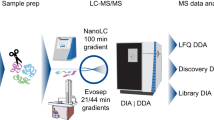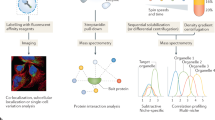Abstract
The subcellular localization of proteins is a posttranslational modification of paramount importance. The ability to study subcellular and organelle proteomes improves our understanding of cellular homeostasis and cellular dynamics. In this chapter, we describe a protocol for the unbiased and high-throughput study of protein subcellular localization in the yeast Saccharomyces cerevisiae: hyperplexed localization of organelle proteins by isotope tagging (hyperLOPIT), which involves biochemical fractionation of Saccharomyces cerevisiae and high resolution mass spectrometry-based protein quantitation using TMT 10-plex isobaric tags. This protocol enables the determination of the subcellular localizations of thousands of proteins in parallel in a single experiment and thereby deep sampling and high-resolution mapping of the spatial proteome.
Access this chapter
Tax calculation will be finalised at checkout
Purchases are for personal use only
Similar content being viewed by others
References
Delic M, Valli M, Graf AB et al (2013) The secretory pathway: exploring yeast diversity. FEMS Microbiol Rev 37:872–914
Li SC, Kane PM (2009) The yeast lysosome-like vacuole: endpoint and crossroads. Biochim Biophys Acta 1793:650–663
Bardwell L (2005) A walk-through of the yeast mating pheromone response pathway. Peptides 26:339–350
Gancedo C, Flores C-L, Gancedo JM (2016) The expanding landscape of moonlighting proteins in yeasts. Microbiol Mol Biol Rev 80:765–777
Chen XJ, Wang X, Kaufman BA et al (2005) Aconitase couples metabolic regulation to mitochondrial DNA maintenance. Science 80(307):714–717
Hope IA, Struhl K (1986) Functional dissection of a eukaryotic transcriptional activator protein, GCN4 of yeast. Cell 46:885–894
Nikolaev Y, Deillon C, Hoffmann SRK et al (2010) The leucine zipper domains of the transcription factors GCN4 and c-Jun have ribonuclease activity. PLoS One 5:e10765
Palmer E, Freeman T (2004) Investigation into the use of C- and N-terminal GFP fusion proteins for subcellular localization studies using reverse transfection microarrays. Comp Funct Genomics 5:342–353
Stadler C, Rexhepaj E, Singan VR et al (2013) Immunofluorescence and fluorescent-protein tagging show high correlation for protein localization in mammalian cells. Nat Methods 10:315–323
Breker M, Gymrek M, Schuldiner M (2013) A novel single-cell screening platform reveals proteome plasticity during yeast stress responses. J Cell Biol 200:839–850
Huh W-K, Falvo JV, Gerke LC et al (2003) Global analysis of protein localization in budding yeast. Nature 425:686–691
Li X-W, Rees JS, Xue P et al (2014) New insights into the DT40 B cell receptor cluster using a proteomic proximity labeling assay. J Biol Chem 289:14434–14447
Hung V, Zou P, Rhee H-W et al (2014) Proteomic mapping of the human mitochondrial intermembrane space in live cells via ratiometric APEX tagging. Mol Cell 55:332–341
Roux KJ, Kim DI, Raida M et al (2012) A promiscuous biotin ligase fusion protein identifies proximal and interacting proteins in mammalian cells. J Cell Biol 196:801–810
Rhee H-W, Zou P, Udeshi ND et al (2013) Proteomic mapping of mitochondria in living cells via spatially restricted enzymatic tagging. Science 339:1328–1331
Rees JS, Li X-W, Perrett S et al (2017) Selective proteomic proximity labeling assay using tyramide (SPPLAT): a quantitative method for the proteomic analysis of localized membrane-bound protein clusters. In: Current protocols in protein science. Wiley, Hoboken, NJ, pp 19.27.1–19.27.18
Christoforou A, Mulvey CM, Breckels LM et al (2016) A draft map of the mouse pluripotent stem cell spatial proteome. Nat Commun 7:9992
de Duve C (1971) Tissue fraction-past and present. J Cell Biol 50:20
Foster LJ, de Hoog CL, Zhang Y et al (2006) A mammalian organelle map by protein correlation profiling. Cell 125:187–199
Itzhak DN, Tyanova S, Cox J et al (2016) Global, quantitative and dynamic mapping of protein subcellular localization. elife 5:e16950
Jean Beltran PM, Mathias RA, Cristea IM et al (2016) A portrait of the human organelle proteome in space and time during cytomegalovirus infection. Cell Syst 3:361–373.e6
Itzhak DN, Davies C, Tyanova S et al (2017) A mass spectrometry-based approach for mapping protein subcellular localization reveals the spatial proteome of mouse primary neurons. Cell Rep 20:2706–2718
Christoforou A, Arias AM, Lilley KS (2014) Determining protein subcellular localization in mammalian cell culture with biochemical fractionation and iTRAQ 8-plex quantification. Methods Mol Biol 1156:157–174
Ross PL, Huang YN, Marchese JN et al (2004) Multiplexed protein quantitation in Saccharomyces cerevisiae using amine-reactive isobaric tagging reagents. Mol Cell Proteomics 3:1154–1169
Rieder SE, Emr SD (2001) Isolation of subcellular fractions from the yeast Saccharomyces cerevisiae. Curr Protoc Cell Biol 8:1–68
Sadowski PG, Dunkley TPJ, Shadforth IP et al (2006) Quantitative proteomic approach to study subcellular localization of membrane proteins. Nat Protoc 1:1778–1789
Dunkley TPJ, Hester S, Shadforth IP et al (2006) Mapping the Arabidopsis organelle proteome. Proc Natl Acad Sci U S A 103:6518–6523
Thompson A, Schäfer J, Kuhn K et al (2003) Tandem mass tags: a novel quantification strategy for comparative analysis of complex protein mixtures by MS/MS. Anal Chem 75:1895–1904
McAlister GC, Nusinow DP, Jedrychowski MP et al (2014) MultiNotch MS3 enables accurate, sensitive, and multiplexed detection of differential expression across cancer cell line proteomes. Anal Chem 86:7150–7158
Mulvey CM, Breckels LM, Geladaki A et al (2017) Using hyperLOPIT to perform high-resolution mapping of the spatial proteome. Nat Protoc 12:1110–1135
Thul PJ, Åkesson L, Wiking M et al (2017) A subcellular map of the human proteome. Science 356:eaal3321
Shliaha PV (2014) Investigation of protein abundance and localization by mass spectrometry and ion-mobility spectrometry-mass spectrometry methods. Dissertation, University of Cambridge
Breckels LM, Mulvey CM, Lilley KS et al (2016) A Bioconductor workflow for processing and analysing spatial proteomics data. F1000Res 5:2926
R Core Team (2017) R: a language and environment for statistical computing. https://www.r-project.org/
Gatto L, Lilley KS (2012) Msnbase-an R/Bioconductor package for isobaric tagged mass spectrometry data visualization, processing and quantitation. Bioinformatics 28:288–289
Gatto L, Breckels LM, Wieczorek S et al (2014) Mass-spectrometry-based spatial proteomics data analysis using pRoloc and pRolocdata. Bioinformatics 30:1322–1324
Gentleman RC, Carey VJ, Bates DM et al (2004) Bioconductor: open software development for computational biology and bioinformatics. Genome Biol 5:R80
Kizer KO, Xiao T, Strahl BD (2006) Accelerated nuclei preparation and methods for analysis of histone modifications in yeast. Methods 40:296–302
Wang Y, Lilley KS, Oliver SG (2014) A protocol for the subcellular fractionation of Saccharomyces cerevisiae using nitrogen cavitation and density gradient centrifugation. Yeast 31:127–135
Villén J, Gygi SP (2008) The SCX/IMAC enrichment approach for global phosphorylation analysis by mass spectrometry. Nat Protoc 3:1630–1638
Breckels LM, Gatto L, Christoforou A et al (2013) The effect of organelle discovery upon sub-cellular protein localisation. J Proteome 88:129–140
Breckels LM, Holden SB, Wojnar D et al (2016) Learning from heterogeneous data sources: an application in spatial proteomics. PLoS Comput Biol 12:e1004920
Baker Brachmann C, Davies A, Cost GJ et al (1998) Designer deletion strains derived fromSaccharomyces cerevisiae S288C: a useful set of strains and plasmids for PCR-mediated gene disruption and other applications. Yeast 14:115–132
Graham JM (2015) Fractionation of subcellular organelles. In: Current protocols in cell biology. Wiley, Hoboken, NJ, pp 3.1.1–3.1.22
Zhang R, Sioma CS, Wang S et al (2001) Fractionation of isotopically labeled peptides in quantitative proteomics. Anal Chem 73:5142–5149
Wenger CD, Lee MV, Hebert AS et al (2011) Gas-phase purification enables accurate, multiplexed proteome quantification with isobaric tagging. Nat Methods 8:933–935
Ting L, Rad R, Gygi SP et al (2011) MS3 eliminates ratio distortion in isobaric multiplexed quantitative proteomics. Nat Methods 8:937–940
McAlister GC, Huttlin EL, Haas W et al (2012) Increasing the multiplexing capacity of TMTs using reporter ion isotopologues with isobaric masses. Anal Chem 84:7469–7478
Acknowledgments
We gratefully acknowledge funding from the BBSRC (CASE studentship BB/I016147/1 to K.S.L. and S.G.O.). We thank Mohamed Elzek for critical reading of the manuscript and suggestions on layout and content.
Author information
Authors and Affiliations
Corresponding author
Editor information
Editors and Affiliations
Rights and permissions
Copyright information
© 2019 Springer Science+Business Media, LLC, part of Springer Nature
About this protocol
Cite this protocol
Nightingale, D.J.H., Oliver, S.G., Lilley, K.S. (2019). Mapping the Saccharomyces cerevisiae Spatial Proteome with High Resolution Using hyperLOPIT. In: Oliver, S.G., Castrillo, J.I. (eds) Yeast Systems Biology. Methods in Molecular Biology, vol 2049. Humana, New York, NY. https://doi.org/10.1007/978-1-4939-9736-7_10
Download citation
DOI: https://doi.org/10.1007/978-1-4939-9736-7_10
Published:
Publisher Name: Humana, New York, NY
Print ISBN: 978-1-4939-9735-0
Online ISBN: 978-1-4939-9736-7
eBook Packages: Springer Protocols




